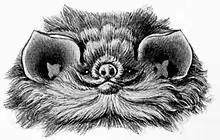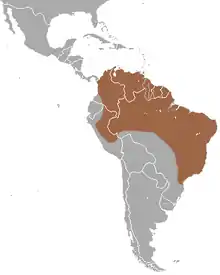Thumbless bat
The thumbless bat (Furipterus horrens) is a species of insectivorous bat in the family Furipteridae, in the monotypic genus Furipterus. It is found in Costa Rica, Brazil, Venezuela; Colombia; Ecuador; Suriname; French Guiana; Guyana; Panama; Trinidad, and Peru. They have a small thumb which is included in the membrane of the wing, causing the 'thumbless' appearance.[3]
| Thumbless Bat | |
|---|---|
 | |
| Scientific classification | |
| Kingdom: | Animalia |
| Phylum: | Chordata |
| Class: | Mammalia |
| Order: | Chiroptera |
| Family: | Furipteridae |
| Genus: | Furipterus Bonaparte, 1837 |
| Species: | F. horrens |
| Binomial name | |
| Furipterus horrens | |
 | |
Taxonomy
The thumbless bat belongs to the family Furipteridae (Mammalia: Chiroptera) which is currently composed of only two genera: Amorphochilus and Furipterus.[4] Both genera are monotypic. The first description of the species was proposed by Frédéric Cuvier in 1828, separating the taxon to a new genus Furia.[2][5] The taxon was reassigned to Furipterus in 1839 by Charles Bonaparte.[6]
Geographic range
The thumbless bat is found in Central and South America. Its range includes Costa Rica, Panama, southern Brazil and Bolivia (Gardner 2008, Peracchi et al. 2011).[7] In Brazil, it was recorded in 12 different regions covering the Amazon, Caatinga, Cerrado and Atlantic Forest biomes (Reis and Gazarini 2007, Tavares et al. 2008, Peracchi et al. 2011).[8]
Population
Its populations are rare and very local, but widespread.[9][10] Male and female bats may live separately during some parts of the year. There were found more than 60 males occupying one hollow.[11]
Habitat
The thumbless bat is found in caves. Additionally, it is associated with moist environments. Thumbless bats were detected significantly more frequently over large lakes(Emmons and Feer 1997).[12] The moist habitat plays a key role for aerial insectivorous bats. However, thumbless bat's activity is significantly higher in forest compared to the lakes. They roots in small clusters in colonies for up to 60 individuals in caves. The nests are located in deep cracks between rocks.
Diet
Thumbless bats are aerial insectivorous bats.
References
- Miller, B.; Reid, F.; Arroyo-Cabrales, J.; Cuarón, A.D.; de Grammont, P.C. (2016). "Furipterus horrens". IUCN Red List of Threatened Species. 2016: e.T8771A21971535. doi:10.2305/IUCN.UK.2016-2.RLTS.T8771A21971535.en.
- Cuvier, F. (1828). "description d'un nouveau genre de chauve-souris sous le nom de Furie". Mémoires du Muséum d'histoire naturelle. G. Dufour. 16: 150.
- Nowak, Ronald (1991). Walker's Mammals of the World (Fifth ed.). The Johns Hopkins University Press. ISBN 978-0-8018-3970-2.
- Simmons, N.B. (2005). Mammals Species of the World: a taxonomic and geographic reference. Chicago: Johns Hopkins University Press.: Order Chiroptera. pp. 312–529.
- Simmons, N.B. (2005). "Order Chiroptera". In Wilson, D.E.; Reeder, D.M (eds.). Mammal Species of the World: A Taxonomic and Geographic Reference (3rd ed.). Johns Hopkins University Press. pp. 312–529. ISBN 978-0-8018-8221-0. OCLC 62265494.
- Simmons, N.B. (2005). "Order Chiroptera". In Wilson, D.E.; Reeder, D.M (eds.). Mammal Species of the World: A Taxonomic and Geographic Reference (3rd ed.). Johns Hopkins University Press. pp. 312–529. ISBN 978-0-8018-8221-0. OCLC 62265494.
- Emmons, L.H (1990). Neotropical rainforest mammals: a field guide. Chicago: University of Chicago Press. p. 281.
- Peracchi, A.L. (2010). Mamíferos do Brasil: guia de identificação. Rio de Janeiro: Technical Books Editora. p. 560.
- Emmons, L.H (1990). Neotropical rainforest mammals: a field guide. Chicago: University of Chicago Press. p. 281.
- Reid, F. (2009). A Field Guide to the Mammals of Central America and Southeast Mexico. Oxford University Press.
- LaVal, R.K. (1977). "Notes on some Costa Rican bats". Brenesia (Museo Nacional de Costa Rica). 10 (11): 77–83.
- Emmons, L.H (1990). Neotropical rainforest mammals: a field guide. Chicago: University of Chicago Press. p. 281.
